Cleanroom ventilation: design and installation rules for ventilation systems
The air that a person inhales inside structures contains many impurities. The level of concentration of its pollution largely depends on various circumstances, including remoteness from intense highways and industrial facilities.
There are such rooms where this situation is unacceptable, because due to their specifics, the ultimate purity of air flow turnover is necessary. Therefore, the arrangement of ventilation systems for clean rooms and air conditioning is an essential component to ensure that they have a suitable microclimate. Do you agree?
From our material you will learn what ventilation of clean rooms, humidity standards, temperature conditions and other parameters affecting the maintenance of an optimal microclimate are.
The content of the article:
What is cleanroom?
The definition of a clean room implies a certain area of a room in which, using special equipment, the concentration of aerosol particles (dust, chemical vapors, microorganisms) in the air is maintained within specified limits.
In such a room, the amount of contaminating particles on the surface of the walls, ceiling and in the air should be kept to a minimum.
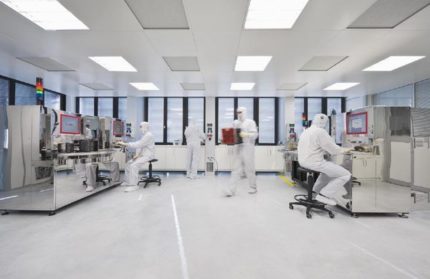
These special rooms are equipped with the following components:
- antistatic floor;
- transfer window openings;
- transition gateways;
- blank design wall panels;
- Ceilings with recessed lighting.
Extremely clean atmosphere in such rooms can be achieved in one way - the displacement of existing air masses and the influx of fresh filtered air-conditioned air.
Clean rooms are necessary for such areas of human activity as medicine, pharmaceuticals, the manufacture of various electronic devices and food production.
Cleanroom air exchange rates
With the development of the latest technology, the need for clean production facilities has increased. Industry uses increasingly expensive and complex materials.
In these conditions, the price of error in the production of modern products due to the mismatch of the industrial environment and equipment of jobs is very high.
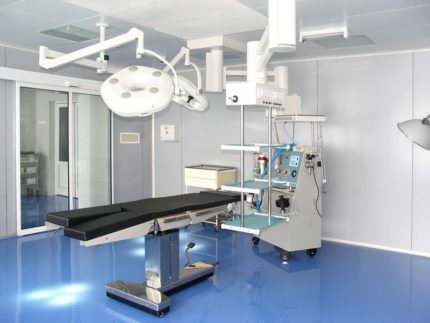
Around the world, a series of standards is a universally recognized document establishing the norms of ventilation of cleanrooms, design, construction, equipment and certification, as well as dividing them into special classes of cleanlinessISO 14644, collectively called “Cleanrooms and their associated control environments”, developed by the International Organization for Standardization (ISO).
This regulatory category includes 9 regulatory documents.
RegulationsISO 14644 "Clean Areas and Associated Controlled Environments."
| Document No. | Short title |
| ISO 14644-1 | Classifier of purity of air masses |
| ISO 14644-2 | Compliance and monitoring standards to confirm complianceISO 14644-1 |
| ISO 14644-3 | Testing Methods |
| ISO 14644-4 | Design, construction process, commissioning |
| ISO 14644-5 | Service |
| ISO 14644-6 | Definitions and Terms |
| ISO 14644-7 | Insulating structures (boxes, shelters with purified air, etc.) |
| ISO 14644-8 | Classifier of molecular air pollution |
| ISO 14644-9 | Classifier of surface cleanliness by particle concentration |
In Russia, an approved selection of GOST R standards is used.ISO 14644, which is a translation of an international standardISO 14644 "Cleanrooms and associated controlled environments."
The documentation regulating Russian standards was developed by the Technical Committee for Standardization TC 184 “Ensuring Industrial Cleanliness” and a public institution by the Association of Control Engineers micro pollution (Asinkom).
Depending on the cleanliness class of the industrial premises and the technical processes carried out in it, different standards are imposed on the equipment and equipment for air exchange.
There are 9 classes of rooms in which a certain concentration of dust and microorganisms in the air is allowed according to GOST ISO 14644-1-2000.
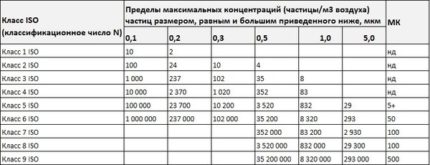
Ventilation air preparation systems must ensure its purity in terms of the number of aerosol particles and, if necessary, the presence of microorganisms in clean areas in accordance with the requirements of GOST R 52249-2009 “Rules for the production and quality control of medicines”.
In addition, they must maintain a pressure differential with respect to the surrounding rooms of a lower purity class.
Required Ventilation Conditions
For the implementation of air exchange in clean rooms, the mobility of air flows in m / s is measured. In particularly sterile rooms in the pharmaceutical industry, the exact definition of the required ventilation is established - 0.46 m / s ± 0.1 m / s (FDA, USA).
The limiting norms of mobility of air masses in other clean rooms, as a rule, are from 0.35 to 0.52 m / s ± 20%.
The presence of window openings also significantly affects the air circulation:
- in a sealed room without windows, the air flow should dominate by 20% over the hood;
- in rooms with windows, air exchange performance should be 30% higher than the hood.
Only such a system of ventilation of clean areas can prevent the ingress of contaminants and ensure the circulation of air masses.
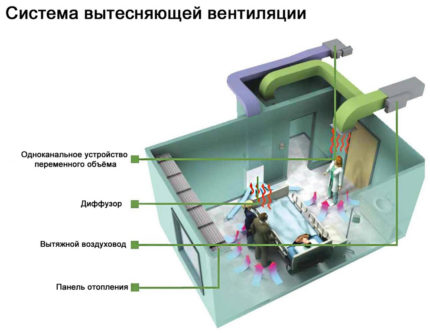
When designing, increased attention is paid to the technology for supplying air flows to special purpose facilities. For example, air circulation in clean rooms with a cleanliness class from 1 to 6 is carried out by air distribution equipment from top to bottom, forming uniform and unidirectional low-velocity air flows from 0.2 to 0.45 m / s.
In areas of lower cleanliness, the formation of a non-unidirectional flow with the help of several ceiling diffusers is allowed.
Air purification methods
Two types of clean rooms can be distinguished. As a rule, they differ among themselves by the method of purification of air masses:
- rooms with turbulent ventilation;
- rooms with laminar flow in one direction.
The latter variety allows you to maintain the highest degree of purity, due to the fact that the direction directed to one side quickly and more efficiently pushes polluted air out of the desired room.
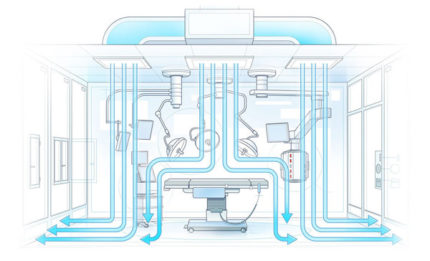
Through the intake grilles located at the bottom of the walls, a part of the displaced air is brought out. During the day the ventilation is installed according to this principle, it can displace exhaust air up to 20 times.
If it is necessary to make the air in a clean room even more purified, a view with a one-way flow is selected. The meaning of laminar ventilation is to equip effective filtering components to supply air flow.
Fresh air entering the room moves along it in one direction (from top to bottom), while the microparticles of dust are delayed and removed through openings in the floor. Typically, this process takes place at an air flow rate of up to 0.4 m / s.
Ventilation equipment
In order to choose effective ventilation equipment in a clean room, it is worth understanding the tasks that it will solve.

The air exchange in clean rooms is not aimed at removing contaminating bacteria and particles, but at preventing their ingress.
The necessary equipment will be as follows:
- Filter ventilation modules. Components of systems whose main function is the purification of air from contaminated particles and impurities. Equipped with filters Hepa andULPA to achieve the required degree of purity according to the classifier.
- Air distributors. This is a group of climatic equipment for purification from impurities, the implementation of ventilation and air conditioning in clean areas.
- Ventilation systems and air conditioning. Installation with a full cycle of preparation of air flows in clean rooms. Its functions include: cleaning, maintaining temperature, humidity and air pressure. Typically, these settings are characterized by uninterrupted silent operation and can adjust the adjustment of indicators automatically.
- Filters of various cleaning classes. Often selected according to the requirements for a particular type of cleanliness of the room. The most effective scheme for removing foreign particles from the supply air by passing it through 4 types of filters - coarse, thin, high efficiency (Hepa) and hyperfine (ULPA) cleaning.
The main task for the continuous operation of this equipment is a high-quality initial design and installation.
Otherwise, the personnel and owners do not experience any difficulties with operation.
The principle of the system
Ventilation of clean rooms is functioning properly and makes it possible to ensure normative indicators by the clear operation of all system components.
Before entering the room, the air goes through four levels of filtration at four filtersthat cleanse the airflow from certain types of pollution.
A laminar air flow is supplied, which allows the directional movement of the cleaned air masses to form, and it, in turn, pushes aerosol particles out of the existing air.
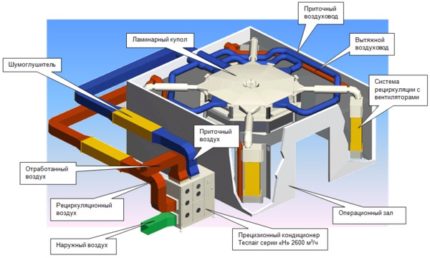
The main component of the entire ventilation unit is the system central air conditioningequipped in accordance with the specifics of clean rooms. Most of the processes of preparation and purification of air takes place here.
And the ease in managing and maintaining constant cleanliness indicators in a room is provided by equipment for automation and dispatching the operation of the entire system, which contains a large number of sensors for monitoring indicators, a device for remote transmission of commands, etc.
After the system is put into operation, the state of operation of all elements is monitored by personnel working in the room, and if any malfunctions or emergency situations are detected, the software will quickly inform you about this automatically.
Design Features of Ventilation Systems
The design and installation of a ventilation and air conditioning system for clean rooms requires the necessary experience with special equipment, as well as knowledge of the requirements and standards for these rooms.
There are three main schemes for organizing air exchange in clean areas:
- air flow direction parallel to each other;
- messy direction - fresh air flows in different directions;
- mixed supply - can be seen in large rooms, when in one part the air masses move in parallel, and in the other - randomly.
Depending on the size of the room and the location of the work area, the most suitable ventilation system design is selected. The most optimal solution is ventilation with a one-way flow of fresh air.
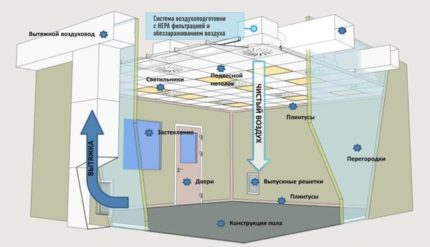
For clean rooms often used supply and exhaust ventilation system. Its meaning is as follows: from above, with a certain speed, a stream of fresh air is supplied under pressure, which pushes the contaminated air masses in the room down to the air inlet.
Cooled air is supplied at low speed to the top of the facility via ceiling panels. It envelops the area of the room, dropping dust particles down to the hood, creating a minimum degree of irritation.
With this ventilation system, drafts and dust vortices settled on the floor are not formed. Moreover, the delivered fresh stream is first prepared and fed into the room already with the desired humidity and temperature.
Popular ventilation schemes
When designing a ventilation system, one of the paramount tasks is the accurate and proven organization of the distribution of air flows.
Currently, designers use several common solutions for the location of air distribution equipment, the choice of which depends on the destination.
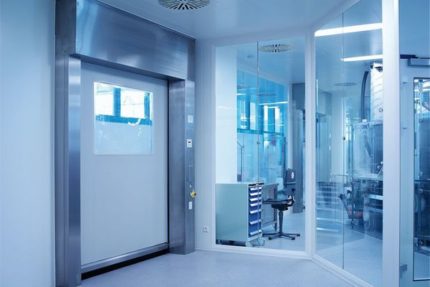
Consider the most popular, proven schemes for organizing ventilation of the operating room:
- air flow in one direction through the inclined ventilation grill;
- with the use of ceiling diffusers not a unidirectional air flow is organized;
- air enters the operating room through a perforated ceiling panel with the organization of a vertical unidirectional air mixture flow;
- the supply air mass is supplied through the air distributor in the ceiling, creating a laminar air flow directed to the working area;
- the air mixture is not unidirectional and is fed through an air ring hose.
The exhaust ventilation system in the operating rooms is carried out by mounting the exhaust fans and wall ventilation grilles with a valve in the opposite direction.
In accordance with practice, the best arrangement for organizing a laminar air flow directed in one direction in the operating rooms are ceiling mesh air diffusers.
For example, on a laminar ceiling measuring 1.8 by 2.4 m in an operating room with an area of 40 m², it makes it possible to create a 25-fold air exchange at an air flow rate of 0.2 m / s from the installation.
These data are considered sufficient for absorption. heat surplus from the number of personnel and equipment operation in the operating room.
Installation of ventilation systems
The peculiarity of the cleanroom ventilation installation is associated with high requirements for various types of zones, the classification of which depends on the features of the technological processes carried out in them, as well as their purpose, microclimate standards and routing of engineering structures.
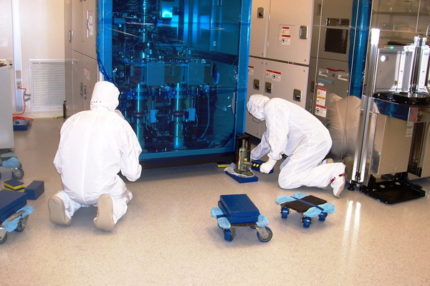
Installation specialists need to understand that air ducts for installation in clean rooms, prior to installation, preparatory procedures are required, without which subsequent installation cannot be carried out.
Consider the main steps:
- At the preparatory stage, the details of the ducts are placed in a designated cleaning area. Before installation, parts and shaped elements are subjected to initial dry mechanical cleaning to remove liquid and solid contaminants from surfaces formed during production and transportation.
- Next, you should conduct a primary wash of all internal surfaces with tap water and arrange for drying until completely dry indust free zone. After visual inspection, components of ventilation systems, depending on the degree of contamination, are subjected to secondary washing and drying or immediately followed by antiseptic treatment.
- After final processing, it is recommended to minimize contact with the cleaned elements of the internal surfaces of the ducts and the room air. This can be achieved by wrapping the end parts with polymer films. After that, the components are sent to a warehouse with controlled purity parameters.
- A cleaned batch of parts and ducts gets to the installation site right before installation. The protective film is removed immediately before connecting the parts of the ducts and shaped elements, while contact with tools, fasteners, open skin limbs with the inside is unacceptable.When stopping the installation or a break, temporary sealing of the end parts, joints and insets should be made.
At all stages of installation work, it is necessary to control and reduce the number of possible contaminants on the internal surfaces.
Conclusions and useful video on the topic
The video will discuss how ventilation is arranged in clean rooms for industrial purposes:
Video about how ventilation is set up in the clean rooms of the operating room:
Design and installation of ventilation systems and air conditioning systems in clean rooms is a laborious process, which requires certain knowledge, norms and rules of air exchange and air supply, as well as skills and experience in the use of air distribution equipment.
That is why for the design and installation of a ventilation system at such facilities, it is recommended to contact specialists only.
If you have questions about the topic of the article or you can supplement our material with valuable information on the arrangement of ventilation in clean rooms. Please leave your comments, share your experience - the block for communication is located under the article.

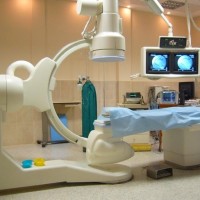 Ventilation and air conditioning for medical institutions: rules and features of the arrangement of ventilation
Ventilation and air conditioning for medical institutions: rules and features of the arrangement of ventilation 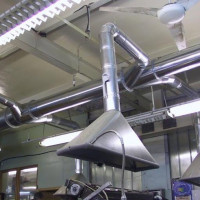 Ventilation of industrial premises: rules for the organization of air exchange
Ventilation of industrial premises: rules for the organization of air exchange  Ventilation of a room with gas-using equipment: design standards + arrangement rules
Ventilation of a room with gas-using equipment: design standards + arrangement rules 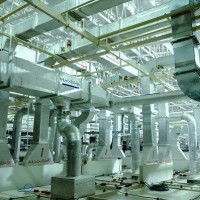 Requirements for ventilation of public buildings: subtleties of arrangement and design of ventilation
Requirements for ventilation of public buildings: subtleties of arrangement and design of ventilation 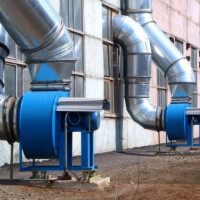 Types of ventilation systems: a comparative overview of the options for organizing ventilation systems
Types of ventilation systems: a comparative overview of the options for organizing ventilation systems 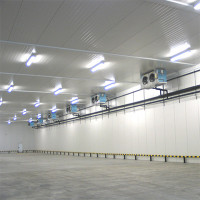 Warehouse and warehouse ventilation: standards, requirements, necessary equipment
Warehouse and warehouse ventilation: standards, requirements, necessary equipment  How much does it cost to connect gas to a private house: the price of organizing gas supply
How much does it cost to connect gas to a private house: the price of organizing gas supply  The best washing machines with dryer: model rating and customer tips
The best washing machines with dryer: model rating and customer tips  What is the color temperature of light and the nuances of choosing the temperature of the lamps to suit your needs
What is the color temperature of light and the nuances of choosing the temperature of the lamps to suit your needs  Replacement of a geyser in an apartment: replacement paperwork + basic norms and requirements
Replacement of a geyser in an apartment: replacement paperwork + basic norms and requirements